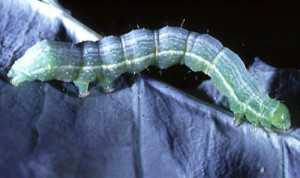Stop Cabbage Loopers From Worming Their Way Into Your Crops

Photo by John L. Capinera
Crops Affected
The cabbage looper (Trichoplusia ni Hübner) feeds on a wide variety of cultivated plants and weeds. As the common name implies, it feeds readily on crucifers but also attacks a wide range of vegetables crops commonly grown in Florida including beans, cucurbits, lettuce, pepper, potato, tomato, and many others. Additional hosts include some ornamentals and a few common agricultural weeds.
Identification
The cabbage looper is found worldwide wherever crucifers are cultivated. In the U.S., it overwinters only in the southernmost states where it poses a year-round threat. Cabbage loopers are leaf feeders, and during the first three instars confine their feeding to the lower leaf surface, leaving the upper surface intact. The fourth and fifth instars chew large holes usually away from the leaf margin. In the case of cabbage, the later instars may bore into the developing head. Larvae consume three times their weight in plant material daily. Feeding sites are marked by large accumulations of sticky, wet fecal material.
Young larvae are initially whitish, but become pale green as they commence feeding on foliage. Larvae have three pairs of prolegs and crawl by arching their back to form a loop then projecting the front section of the body forward. The mature larva is predominantly green and is usually marked with a distinct white stripe on each side.
The moth is mottled gray-brown in color. The hind wings are light brown at the base with the distal portions dark brown. The forewing bears silvery white spots, which serve to distinguish cabbage looper from most other crop-feeding noctuid moths.
Survival And Spread
The cabbage looper moth is highly dispersive, and can fly up to 200 kilometers. Eggs are deposited singly on either the upper or lower surface of the leaf, although clusters of six to seven eggs are not uncommon. The number of instars ranges from four to seven. Life cycle is highly temperature dependent with shorter cycles under higher temperatures.
Looper populations are somewhat variable in occurrence, being very abundant one year, and then scarce for two to three years. This is likely due to natural infections by nuclear polyhedrosis virus.
Management Methods
Various Bt formulations have long been used for effective suppression of cabbage looper, and have the advantage of not disrupting populations of beneficial insects. Over the past few years, chemical manufacturers have produced a variety of new tools in the battle against leps so that growers now have a wide array of excellent worm control materials in their arsenal.
Growers are reminded to rotate between products of different chemical classes to avoid the buildup of possible pest resistance. The range of materials to choose from and the use of IRAC numbers make this task relatively easy to do.
Insecticide resistance has become a problem in cabbage looper control, but susceptibility varies widely among locations. Row covers, where economically practical, may be effective at preventing moths from depositing eggs on crops.
Consult UF/IFAS recommendations for currently labeled insecticides for cabbage looper control in Florida vegetables.










